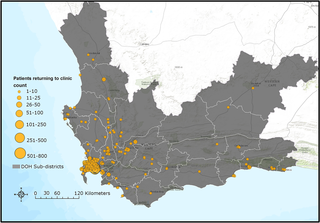PLOS Medicine ( IF 15.8 ) Pub Date : 2017-11-07 , DOI: 10.1371/journal.pmed.1002407 Samantha R. Kaplan , Christa Oosthuizen , Kathryn Stinson , Francesca Little , Jonathan Euvrard , Michael Schomaker , Meg Osler , Katherine Hilderbrand , Andrew Boulle , Graeme Meintjes

|
Background
Retention in care is an essential component of meeting the UNAIDS “90-90-90” HIV treatment targets. In Khayelitsha township (population ~500,000) in Cape Town, South Africa, more than 50,000 patients have received antiretroviral therapy (ART) since the inception of this public-sector program in 2001. Disengagement from care remains an important challenge. We sought to determine the incidence of and risk factors associated with disengagement from care during 2013–2014 and outcomes for those who disengaged.
Methods and findings
We conducted a retrospective cohort study of all patients ≥10 years of age who visited 1 of the 13 Khayelitsha ART clinics from 2013–2014 regardless of the date they initiated ART. We described the cumulative incidence of first disengagement (>180 days not attending clinic) between 1 January 2013 and 31 December 2014 using competing risks methods, enabling us to estimate disengagement incidence up to 10 years after ART initiation. We also described risk factors for disengagement based on a Cox proportional hazards model, using multiple imputation for missing data. We ascertained outcomes (death, return to care, hospital admission, other hospital contact, alive but not in care, no information) after disengagement until 30 June 2015 using province-wide health databases and the National Death Registry. Of 39,884 patients meeting our eligibility criteria, the median time on ART to 31 December 2014 was 33.6 months (IQR 12.4–63.2). Of the total study cohort, 592 (1.5%) died in the study period, 1,231 (3.1%) formally transferred out, 987 (2.5%) were silent transfers and visited another Western Cape province clinic within 180 days, 9,005 (22.6%) disengaged, and 28,069 (70.4%) remained in care. Cumulative incidence of disengagement from care was estimated to be 25.1% by 2 years and 50.3% by 5 years on ART. Key factors associated with disengagement (age, male sex, pregnancy at ART start [HR 1.58, 95% CI 1.47–1.69], most recent CD4 count) and retention (ART club membership, baseline CD4) after adjustment were similar to those found in previous studies; however, notably, the higher hazard of disengagement soon after starting ART was no longer present after adjusting for these risk factors. Of the 9,005 who disengaged, the 2 most common initial outcomes were return to ART care after 180 days (33%; n = 2,976) and being alive but not in care in the Western Cape (25%; n = 2,255). After disengagement, a total of 1,459 (16%) patients were hospitalized and 237 (3%) died. The median follow-up from date of disengagement to 30 June 2015 was 16.7 months (IQR 11–22.4). As we included only patient follow-up from 2013–2014 by design in order to maximize the generalizability of our findings to current programs, this limited our ability to more fully describe temporal trends in first disengagement.
Conclusions
Twenty-three percent of ART patients in the large cohort of Khayelitsha, one of the oldest public-sector ART programs in South Africa, disengaged from care at least once in a contemporary 2-year period. Fifty-eight percent of these patients either subsequently returned to care (some “silently”) or remained alive without hospitalization, suggesting that many who are considered “lost” actually return to care, and that misclassification of “lost” patients is likely common in similar urban populations.
A challenge to meeting ART retention targets is developing, testing, and implementing program designs to target mobile populations and retain them in lifelong care. This should be guided by risk factors for disengagement and improving interlinkage of routine information systems to better support patient care across complex care platforms.
中文翻译:

南非Khayelitsha地区当代抗逆转录病毒疗法的脱离:一项队列研究
背景
保持护理是实现联合国艾滋病规划署“ 90-90-90”艾滋病毒治疗目标的重要组成部分。自2001年该公共部门计划启动以来,在南非开普敦的Khayelitsha镇(人口约500,000),已有50,000多名患者接受了抗逆转录病毒疗法(ART)。脱离护理仍然是一个重要的挑战。我们试图确定2013-2014年间脱离护理的发生率和风险因素,以及脱离护理者的结局。
方法和发现
我们进行了一项回顾性队列研究,研究对象为2013年至2014年期间访问13家哈耶利特沙ART诊所中的任何一家≥10岁的患者,而不论他们发起ART的日期如何。我们使用竞争风险方法描述了2013年1月1日至2014年12月31日期间首次脱离的累积发生率(> 180天未就诊),使我们能够估计ART开展后长达10年的脱离发生率。我们还根据Cox比例风险模型描述了脱离的风险因素,对缺失的数据使用了多重插补。分离后直至2015年6月30日,我们使用全省范围的健康数据库和国家死亡登记系统确定了结果(死亡,重返病房,入院,其他医院联系,是否活着但没有护理,没有信息)。39岁 符合我们入选标准的884例患者中,截至2014年12月31日接受ART治疗的中位时间为33.6个月(IQR 12.4–63.2)。在整个研究队列中,有592名(1.5%)在研究期间死亡,有1,231名(3.1%)正式转出,有987名(2.5%)是无声转诊并在180天内访问了西开普省另一家诊所,有9,005名(22.6%)脱离,有28,069(70.4%)人仍在护理中。在ART上,脱离护理的累积发生率在2年时估计为25.1%,在5年时为50.3%。调整后与脱离有关的关键因素(年龄,男性,ART开始妊娠[HR 1.58,95%CI 1.47-1.69],最近的CD4计数)和保留率(ART俱乐部会员资格,基线CD4)与在研究中发现的因素相似。之前的学习; 但是,值得注意的是 在调整了这些危险因素后,开始进行抗逆转录病毒治疗后不久脱离的较高危险就不再存在。在解散的9,005名患者中,最常见的2种初始结局是180天后恢复接受ART护理(33%;n = 2,976),并且在西开普省还活着但没有得到照顾(25%;n = 2,255)。脱离接触后,总共有1459(16%)名患者住院治疗,死亡237名(3%)。从分离之日到2015年6月30日的中位随访时间为16.7个月(IQR 11–22.4)。由于我们仅按设计纳入了2013-2014年的患者随访资料,以最大程度地将研究结果推广至当前计划,因此,这限制了我们更全面地描述初次脱离时态趋势的能力。
结论
在Khayelitsha大型队列中,有23%的ART患者是当代最古老的公共部门ART计划之一,在当代的2年时间内,至少有一次脱离了护理。这些患者中有58%随后返回治疗(有些“默默地”)或没有住院就活着,这表明许多被认为“丢失”的患者实际上已恢复治疗,“丢失”患者的错误分类很可能在以下地区很常见。类似的城市人口。
达到ART保留目标的挑战是开发,测试和实施计划设计,以针对流动人群并将其保留在终生护理中。这应该以脱离风险的风险因素为指导,并改善常规信息系统的相互联系,以更好地支持复杂护理平台之间的患者护理。



























 京公网安备 11010802027423号
京公网安备 11010802027423号